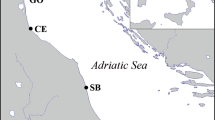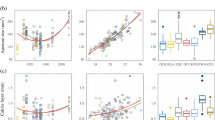Abstract
Many marine invertebrates produce mineralized skeletons whose form suggests an economical construction. Porous as opposed to solid skeletal components are produced by sclerac-tinian corals1,2, balanoid and coronuloid barnacles3, ostreid and hippuritid bivalves4, and almost all modern echinoderm classes5,6. They were also produced by rudist bivalves which were widely successful in Cretaceous tropical seas7. Marine proso-branch gastropods produce a stout external shell sculpture in place of a uniformly thick, ultimately stronger shell8,9. The costs implied by these patterns of economical skeleton construction, however, are unknown10–12. The term ‘cost’ refers to an evolutionary cost measured in terms of reduced fitness. Note that not all such costs are energetic; non-energetic constraints may also influence fitness. I present here evidence that both thick- and thin-shelled morphs of Thais (=Nucella) lamellosa (Gastropoda, Prosobranchia) produce shell material at a remarkably similar rate during maximal growth. Thick-shelled animals, however, exhibit a significantly slower rate of body growth. These results suggest that rates of skeletal growth can limit the rate of body growth and that this limitation represents a potentially important evolutionary cost.
This is a preview of subscription content, access via your institution
Access options
Subscribe to this journal
Receive 51 print issues and online access
$199.00 per year
only $3.90 per issue
Buy this article
- Purchase on Springer Link
- Instant access to full article PDF
Prices may be subject to local taxes which are calculated during checkout
Similar content being viewed by others
References
Chamberlain, J. A. Jr Palaeobiology 4, 419–435 (1978).
Sorauf, J. E. Palaeontology 15, 88–107 (1972).
Newman, W. A. & Ross, A. San Diego Soc. nat. Hist. Mem. 9, 1–108 (1976).
Carter, J. G. in Skeletal Growth of Aquatic Organisms (eds Rhoads, D. C. & Lutz, R. A.) 69–114 (Plenum, New York, 1980).
Raup, D. M. in The Physiology of Echinodermata (ed. Boolootian, R. A.) 379–395 (Wiley, New York, 1966).
Weber, J., Greer, R., Voight, B., White, E. & Roy, R. J. ultrastruct. Res. 26, 355–366 (1969).
Kauffman, E. G. & Sohl, N. F. Verh. naturf. Ges. Basel 84, 399–467 (1974).
Palmer, A. R. Evolution 33, 697–713 (1979).
Vermeij, G. J. Biogeography and Adaptation: Patterns of Marine Life, 416 (Harvard University Press, Cambridge, 1978).
Rachootin, S. in Encyclopedia of Paleontology (Dowden, Hutchinson & Ross, Stroudsburg, 1979).
Simkiss, K. in The Mechanisms of Mineralization in Invertebrates and Plants (eds Watabe, N. & Wilbur, K. M.) 1–32 (University of South Carolina Press, 1976).
Taylor, J. D. & Layman, M. Paleontology 15, 73–87 (1972).
Bourget, E. & Crisp, D. J. J. mar. biol. Ass. U.K. 55, 231–249 (1975).
Zischke, J. A., Watabe, N. & Wilbur, K. M. Malacologia 10, 423–429 (1970).
Galtsoff, P. S. Ecol. Monogr. 4, 481–490 (1934).
Worsnop, E. & Orton, J. H. Nature 111, 14–15 (1923).
Rhoads, D. C. & Lutz, R. A. J. mar. Res. 28, 150–178 (1970).
Zolotarev, V. N. & Ignat'ev, A. V. Sov. J. mar. Biol. 3, 352–358 (1977).
Highsmith, R. C. J. exp. mar. Biol. Ecol. 37, 105–125 (1979).
Buddemeier, R. W. & Kinzie, R. A. III Oceanogr. mar. Biol. A. Rev. 14, 183–225 (1976).
Buddemeier, R. W., Maragos, J. E. & Knutson, D. W. J. exp. mar. Biol. Ecol. 14, 179–200 (1974).
Polyakov, D. M. & Krasnov, E. V. Sov. J. mar. Biol. 2, 391–396 (1976).
Goreau, T. F. Biol. Bull. 116, 59–75 (1959).
Hickman, R. W. Mar. Biol. 51, 311–327 (1979).
Swan, E. F. Ecology 33, 365–374 (1952).
Raup, D. M. J. Geol. 66, 668–677 (1958).
Raup, D. M. in Physiology of Echinodermata (ed. Boolootian, R. A.) 379–395 (Interscience, New York, 1966).
Seed, R. & Brown, R. A. J. Anim. Ecol. 47, 283–292 (1978).
Darwin, C. A Monograph of the Subclass Cirripedia. The Balanidae, the Verrucidae, etc. (Ray Society, London, 1854).
Pilsbry, H. R. U.S. nat. Mus. Bull. 93, 1–366 (1916).
Abbott, R. T. American Seashells, 663 (Van Nostrand Reinhold, New York, 1974).
Keen, A. M. Sea Shells of Tropical West America, 1064 (Stanford University Press, 1971).
White, E. I. in Studies on Fossil Vertebrates (ed. Westoll, T. S.) 212–234 (Athlone, London, 1958).
Crenshaw, M. A. in Skeletal Growth of Aquatic Organisms (eds Rhoads, D. C. & Lutz, R. A.) 115–132 (Plenum, New York, 1980).
Ingle, S. E. Mar. Chem. 3, 301–319 (1975).
Li, Y. H., Takahashi, T. & Broecker, W. S. J. geophys. Res. 74, 5507–5525 (1969).
Lees, A. Mar. Geol. 19, 159–198 (1975).
Jones, D. S. Palaeobiology 6, 331–340 (1980).
Taylor, J. D. Palaeontology 16, 519–534 (1973).
Palmer, A. R. Malacologia (in the press).
Palmer, A. R. thesis, Univ. Washington (1980).
Author information
Authors and Affiliations
Rights and permissions
About this article
Cite this article
Palmer, A. Do carbonate skeletons limit the rate of body growth?. Nature 292, 150–152 (1981). https://doi.org/10.1038/292150a0
Received:
Accepted:
Issue Date:
DOI: https://doi.org/10.1038/292150a0
This article is cited by
-
Environmental influence on calcification of the bivalve Chamelea gallina along a latitudinal gradient in the Adriatic Sea
Scientific Reports (2019)
-
Phytoplankton uptake and growth rate in the Japanese egg cockle Fulvia mutica
International Aquatic Research (2019)
-
Cue specificity of predator-induced phenotype in a marine snail: is a crab just a crab?
Marine Biology (2019)
-
Decadal longevity and slow growth rates in the deep-water sea pen Halipteris finmarchica (Sars, 1851) (Octocorallia: Pennatulacea): implications for vulnerability and recovery from anthropogenic disturbance
Hydrobiologia (2015)
-
Higher calcification costs at lower temperatures do not break the temperature-size rule in an intertidal gastropod with determinate growth
Marine Biology (2013)
Comments
By submitting a comment you agree to abide by our Terms and Community Guidelines. If you find something abusive or that does not comply with our terms or guidelines please flag it as inappropriate.



